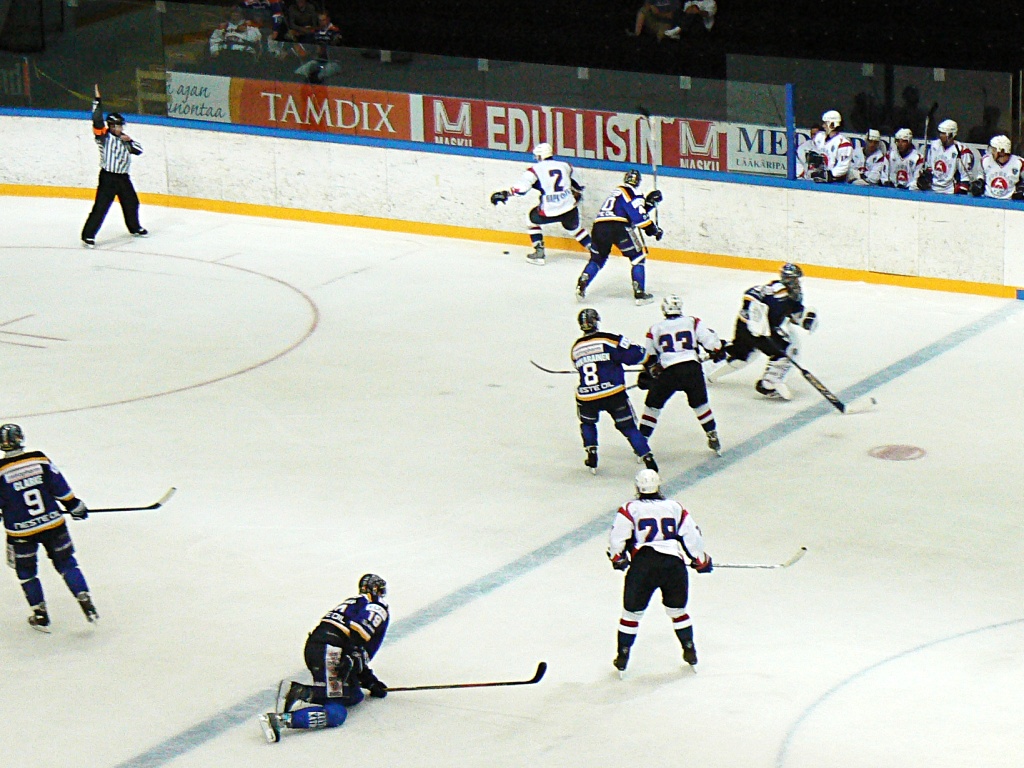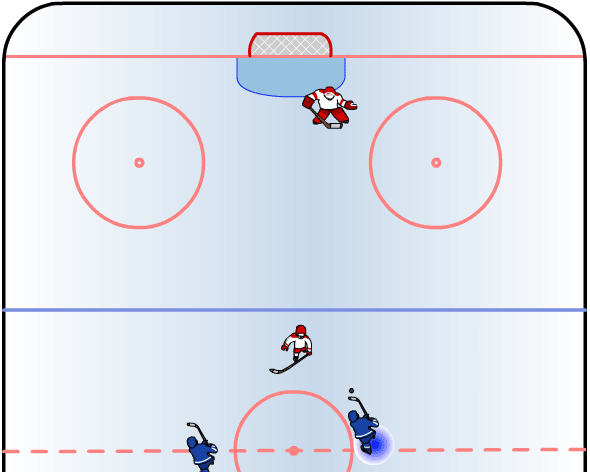|
Brad Werenka
John Bradley Werenka (born February 12, 1969) is a Canadian former professional ice hockey defenceman. He was drafted by the Edmonton Oilers in the second round of the 1987 NHL Entry Draft, 42nd overall. Werenka played college hockey for the Northern Michigan University Wildcats, with whom he won the 1991 NCAA hockey title. In addition to his minor pro experience, Werenka went on to play for the Oilers, Quebec Nordiques, Chicago Blackhawks, Pittsburgh Penguins, and Calgary Flames. His career was ended December 29, 2000 due to a concussion suffered in a game. He represented Canada at the 1994 Winter Olympics The 1994 Winter Olympics, officially known as the XVII Olympic Winter Games (; ) and commonly known as Lillehammer '94, were an international winter multi-sport event held from 12 to 27 February 1994 in and around Lillehammer, Norway. Hav ..., winning a silver medal and being named to the All-Star Team. Awards and honors Career statistics Regular season an ... [...More Info...] [...Related Items...] OR: [Wikipedia] [Google] [Baidu] |
Defenceman
Defence or defense (in American English) in ice hockey is a player position that is primarily responsible for preventing the opposing team from Goal (ice hockey), scoring. They are often referred to as defencemen, D, D-men or blueliners (the latter a reference to the blue line in ice hockey which represents the boundary of the offensive zone; defencemen generally position themselves along the line to keep the puck in the zone). They were once called cover-point. In regular play, two defencemen complement three Forward (ice hockey), forwards and a goaltender on the ice. Exceptions include Overtime (ice hockey), overtime during the regular season and when a team is short-handed (i.e. has been assessed a penalty), in which two defencemen are typically joined by only two forwards and a goaltender; when a team is on the Power play (sporting term), power play (i.e. the opponent has been assessed a penalty), teams will often play only one defenceman, joined by four forwards and a goal ... [...More Info...] [...Related Items...] OR: [Wikipedia] [Google] [Baidu] |
American Hockey Coaches Association
The American Hockey Coaches Association was formed in 1947 in Boston. The founding members coached college ice hockey but membership has grown to include coaches at every level of the sport from youth hockey to professional ice hockey, although the organization maintains a focus on the collegiate game. Aside from its collaborative and community functions, the association also names several award winners each year, most significantly the college ice hockey All-Americans in both divisions and both genders. They also name the top coach in each of the divisions and genders: * Spencer Penrose Award, Division I men * AHCA Coach of the Year, Division I women * Edward Jeremiah Award, Division III men *Women's Division III Coach of the Year The organization also awards the Terry Flanagan Award, given to an assistant coach each year in recognition of the coach's entire career. References Ice Ice is water that is frozen into a solid state, typically forming at or below ... [...More Info...] [...Related Items...] OR: [Wikipedia] [Google] [Baidu] |
Penalty (ice Hockey)
A penalty in ice hockey is a punishment for an infringement of the rules. Most penalties are enforced by sending the offending player to a penalty box for a set number of minutes. During the penalty the player may not participate in play. Penalties are called and enforced by the Official (ice hockey)#Referees, referee, or in some cases, the Official (ice hockey)#Linesmen, linesman. The offending team may not replace the player on the ice (although there are some exceptions, such as fighting), leaving them short handed, short-handed as opposed to full strength. When the opposing team is said to be on a ''Power play (ice hockey), power play'', they will have one more player on the ice than the short-handed team. The short-handed team is said to be "on the penalty kill" until the penalty expires and the penalized player returns to play. While standards vary somewhat between leagues, most leagues recognize several common varieties of penalties, as well as common infractions. The statist ... [...More Info...] [...Related Items...] OR: [Wikipedia] [Google] [Baidu] |
Point (ice Hockey)
In ice hockey, a player is credited with one point for either a goal or an assist. The total number of goals plus assists equals total points. In the National Hockey League The National Hockey League (NHL; , ''LNH'') is a professional ice hockey league in North America composed of 32 teams25 in the United States and 7 in Canada. The NHL is one of the major professional sports leagues in the United States and Cana ... (NHL), the Art Ross Trophy is awarded to the player who leads the league in points at the end of the regular season. References NHL Rulebook, Rule #78– Goals and Assists {{Ice hockey navbox Ice hockey statistics Ice hockey terminology ... [...More Info...] [...Related Items...] OR: [Wikipedia] [Google] [Baidu] |
Assist (ice Hockey)
In ice hockey, an assist is attributed to up to two players of the scoring team who shot, passed or deflected the Puck (sports)#In ice hockey, puck towards the scoring teammate, or touched it in any other way which enabled the Goal (ice hockey), goal, meaning that they were "assisting" in the goal. There can be a maximum of two assists per goal. The assists will be awarded in the order of play, with the last player to pass the puck to the goal scorer getting the primary assist and the player who passed it to the primary assister getting the secondary assist. Players who gain an assist will get one point (ice hockey), point added to their player statistics. When a player scores a goal or is awarded a primary or secondary assist, they will be given a point. The leader of total points throughout an NHL season will be awarded the Art Ross trophy. Despite the use of the terms "primary assist" and "secondary assist", neither is worth more than the other, and neither is worth more or less ... [...More Info...] [...Related Items...] OR: [Wikipedia] [Google] [Baidu] |
Goal (ice Hockey)
In ice hockey, a goal is scored when the puck entirely crosses the goal line between the two goal posts and below the goal crossbar. A goal awards one point to the team attacking the goal scored upon, regardless of which team the player who actually deflected the puck into the goal belongs to (see also own goal). Typically, a player on the team attempting to score shoots the puck with their stick towards the goal net opening, and a player on the opposing team called a goaltender tries to block the shot to prevent a goal from being scored against their team. The term goal may also refer to the structure in which goals are scored. The ice hockey goal is rectangular in shape; the front frame of the goal is made of steel tube painted red and consists of two vertical goalposts and a horizontal crossbar. A net is attached to the back of the frame to catch pucks that enter the goal and also to prevent pucks from entering it from behind. The entire goal is considered an inbounds area ... [...More Info...] [...Related Items...] OR: [Wikipedia] [Google] [Baidu] |
Season (sports)
In an organized sports league, a typical season is the portion of one year in which regulated games of the sport are in session: for example, in Major League Baseball the season lasts approximately from the last week of March to the last week of September. In other team sports, like association football or basketball, it is generally from August or September to May although in some countries – such as Northern Europe, North America or East Asia – the season for oudoor summer sports starts in the spring and finishes in autumn, mainly due to weather conditions encountered during the winter. A year can often be broken up into several distinct sections (sometimes themselves called seasons). These are: a preseason, usually a series of exhibition games played for training purposes; a regular season, the main period of the league's competition; the postseason, a playoff tournament played against the league's top teams to determine the league's champion; and the offseason, the time w ... [...More Info...] [...Related Items...] OR: [Wikipedia] [Google] [Baidu] |
Playoffs
The playoffs, play-offs, postseason or finals of a sports league are a competition played after the regular season by the top competitors to determine the league champion or a similar accolade. Depending on the league, the playoffs may be either a single game, a series of games, or a tournament, and may use a Single-elimination tournament, single-elimination system or one of several other playoff format, different playoff formats. Playoff, in regard to international fixtures, is to qualify or progress to the next round of a competition or tournament. In team sports in the U.S. and Canada, the vast distances and consequent burdens on cross-country travel have led to regional divisions of teams. Generally, during the regular season, teams play more games in their division than outside it, but the league's best teams might not play against each other in the regular season. Therefore, in the postseason a playoff series is organized. Any group-winning team is eligible to participate, ... [...More Info...] [...Related Items...] OR: [Wikipedia] [Google] [Baidu] |
Regular Season
In an organized sports league, a typical season is the portion of one year in which regulated games of the sport are in session: for example, in Major League Baseball the season lasts approximately from the last week of March to the last week of September. In other team sports, like association football or basketball, it is generally from August or September to May although in some countries – such as Northern Europe, North America or East Asia – the season for oudoor summer sports starts in the spring and finishes in autumn, mainly due to weather conditions encountered during the winter. A year can often be broken up into several distinct sections (sometimes themselves called seasons). These are: a preseason, usually a series of exhibition games played for training purposes; a regular season, the main period of the league's competition; the postseason, a playoff tournament played against the league's top teams to determine the league's champion; and the offseason, the time w ... [...More Info...] [...Related Items...] OR: [Wikipedia] [Google] [Baidu] |
List Of NCAA Division I Men's Ice Hockey All-Tournament Teams
NCAA All-Tournament team is an honor bestowed at the conclusion of the NCAA Division I ice hockey tournament to the players judged to have performed the best during the championship. The team is currently composed of three forwards, two defensemen and one goaltender with additional players named in the event of a tie. Voting for the honor was conducted by the head coaches of each member team once the tournament has completed and any player regardless of their team's finish is eligible. The All-Tournament Team began being awarded after the first championship in 1948 along with an All-Tournament Second-Team. The second team was dropped after the 1969 tournament and it has remained a single team ever since except for 1976 when no team was selected. In recent years the regional tournaments have begun to name all-tournament teams of their own, making the NCAA All-Tournament team draw only from the teams and performances in the Frozen Four. In two years (1973 and 1992 1992 ... [...More Info...] [...Related Items...] OR: [Wikipedia] [Google] [Baidu] |




